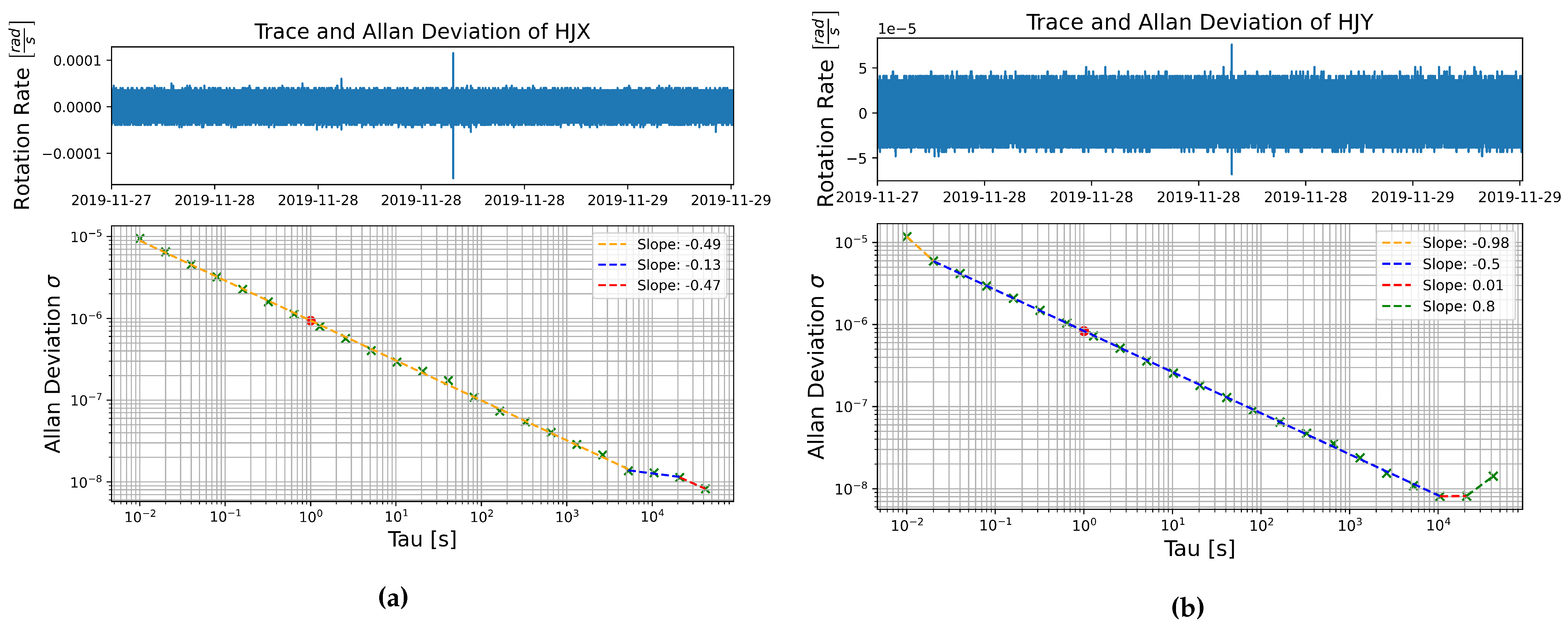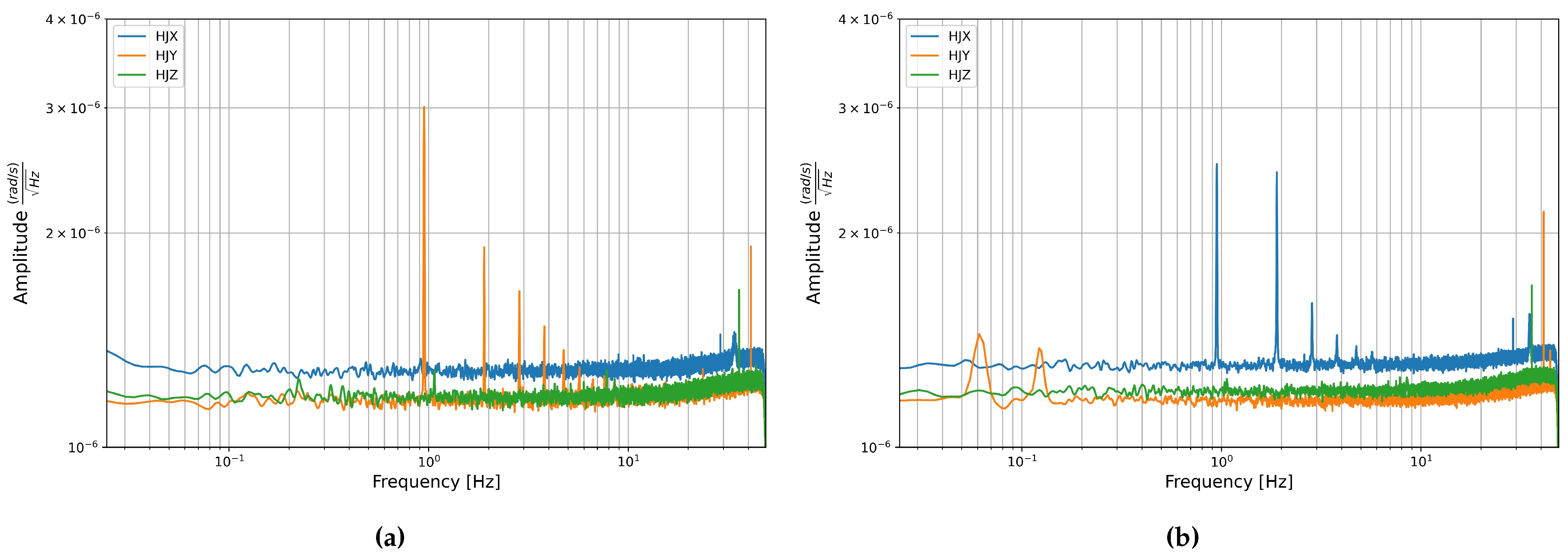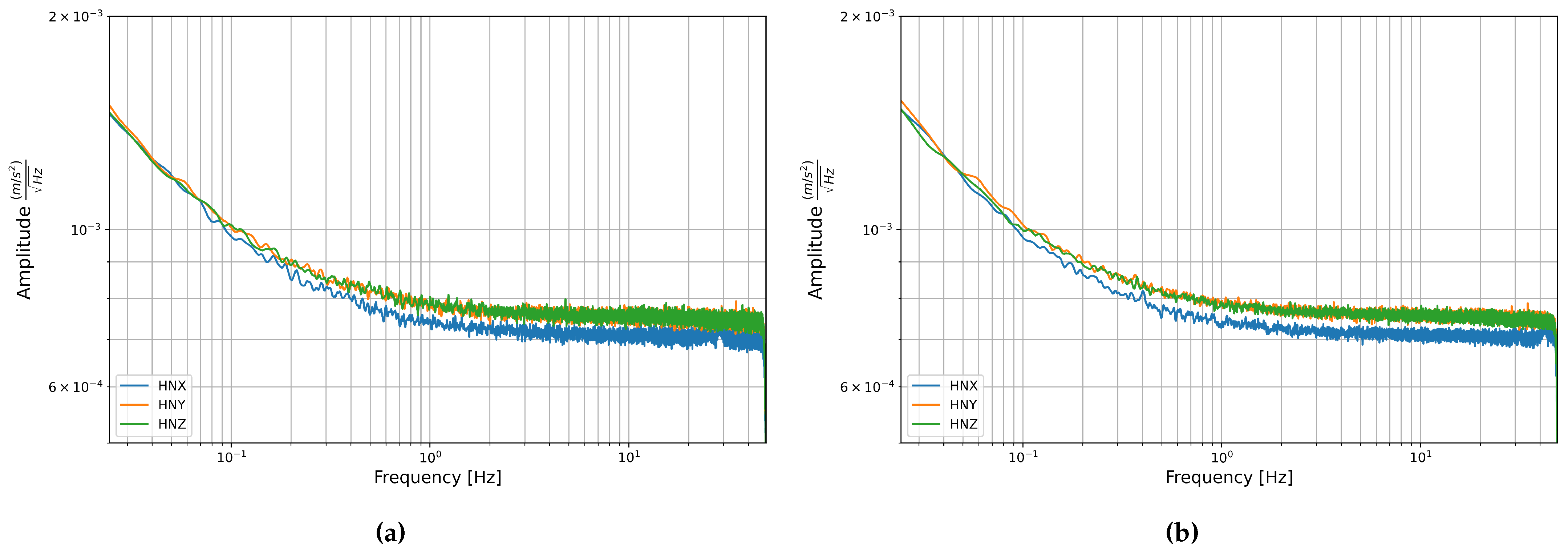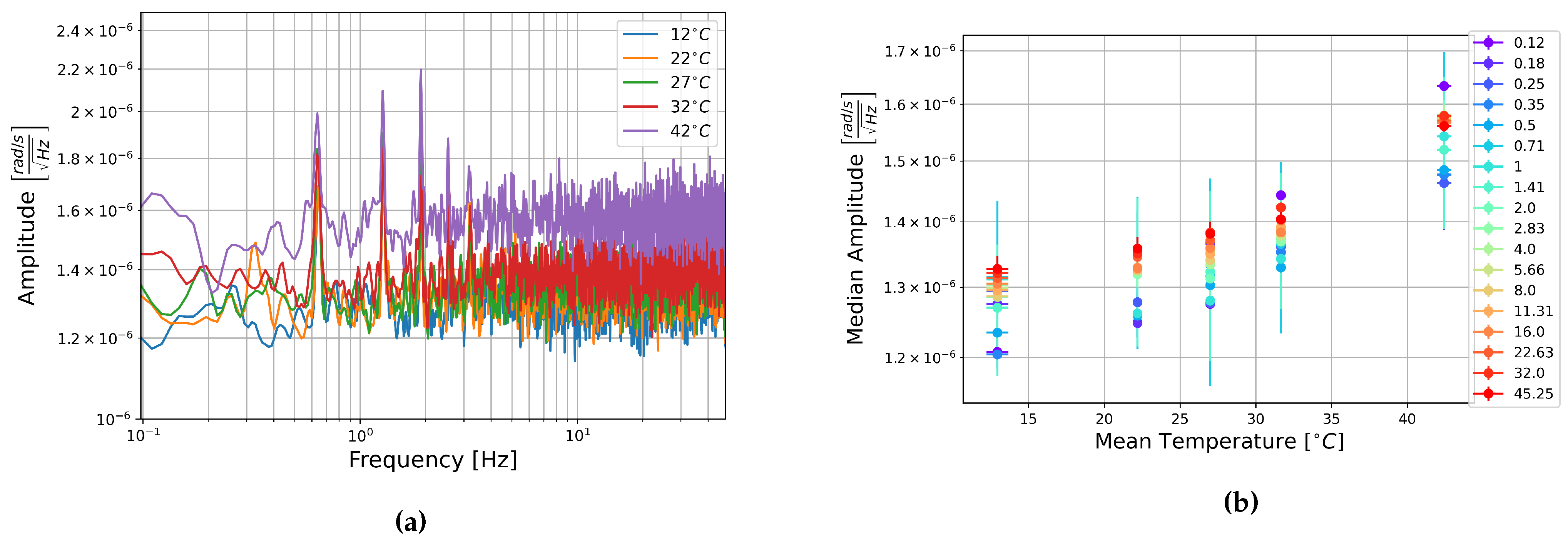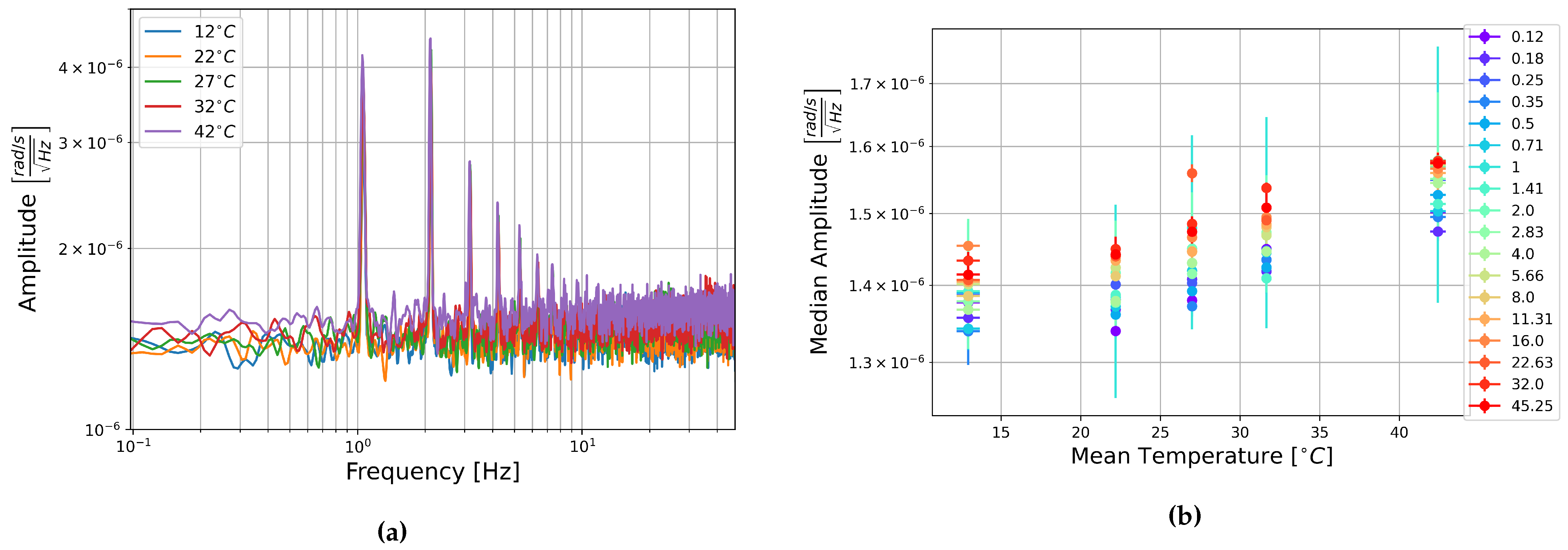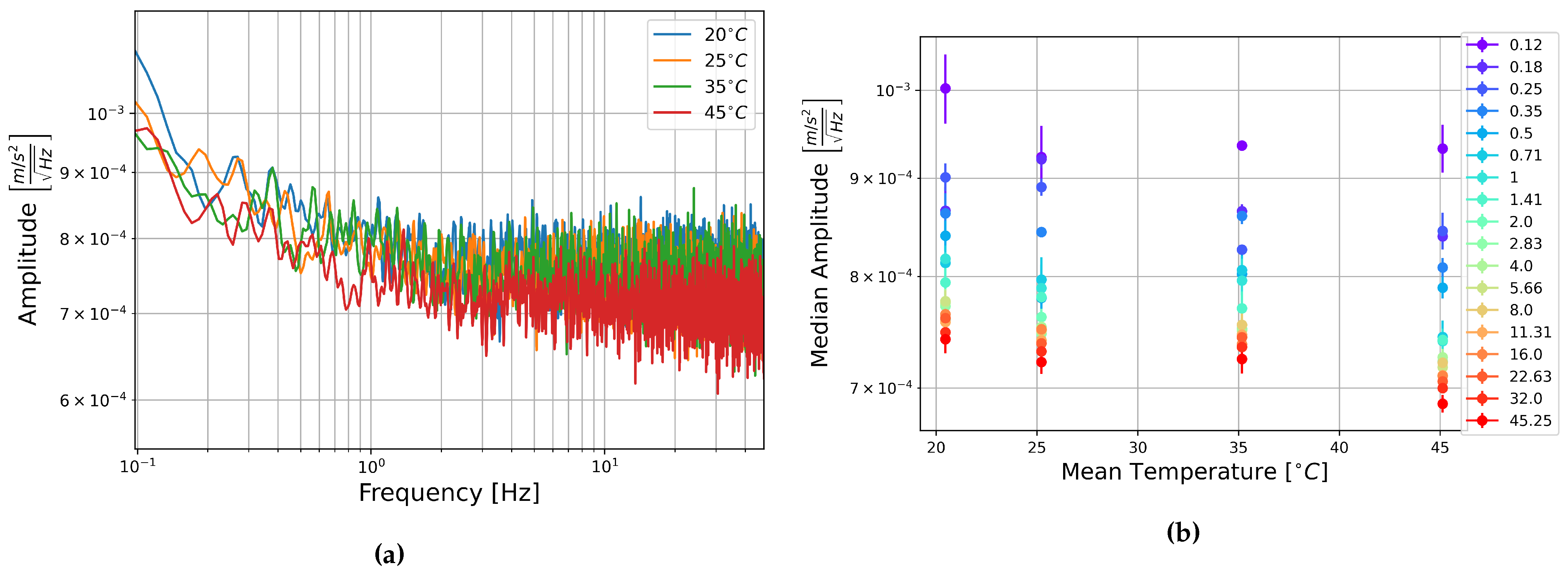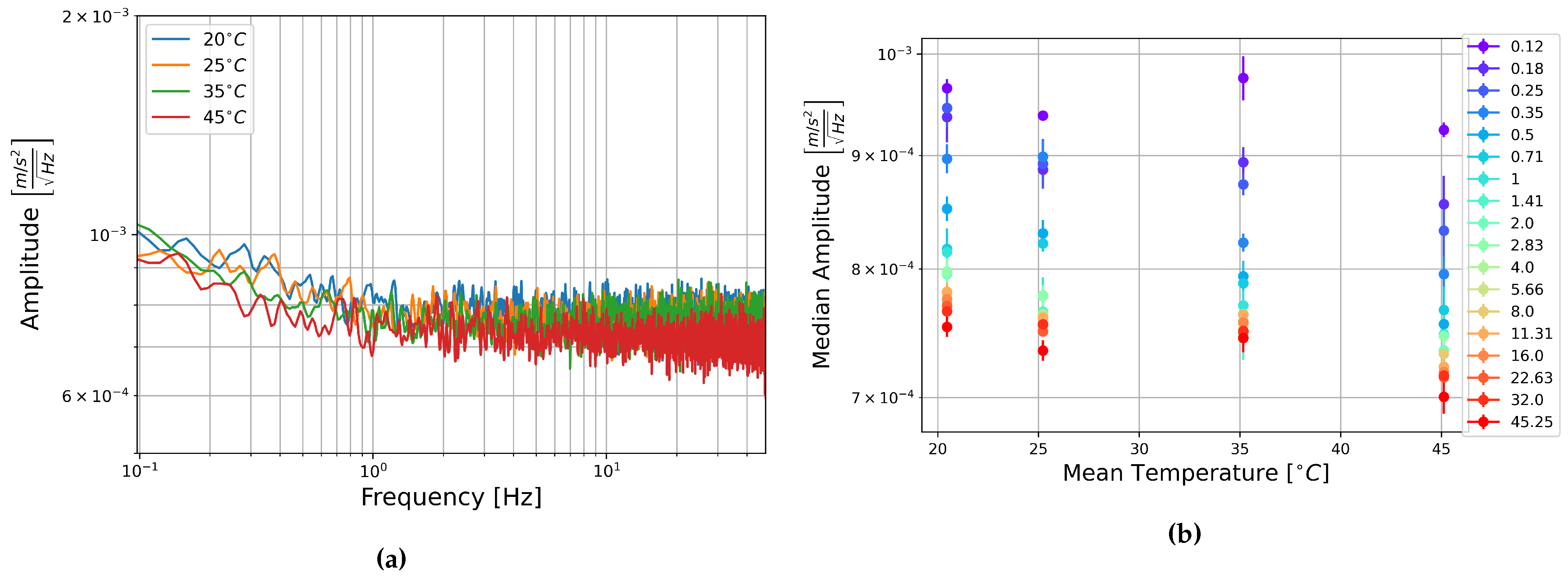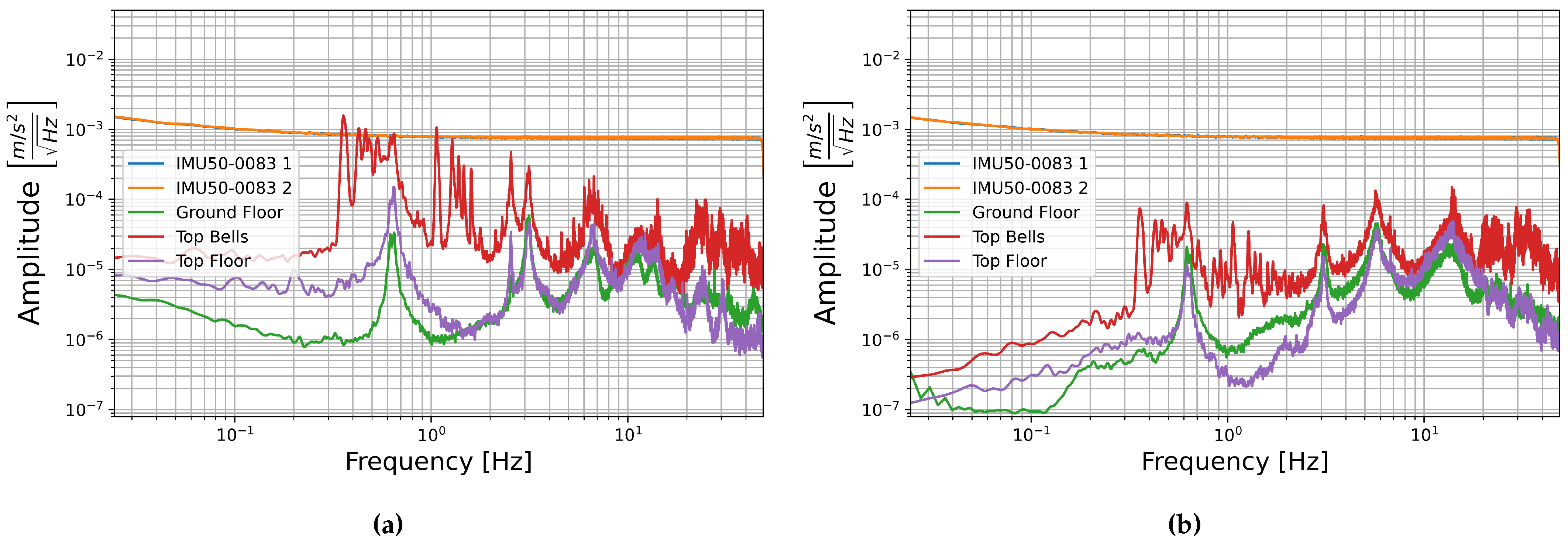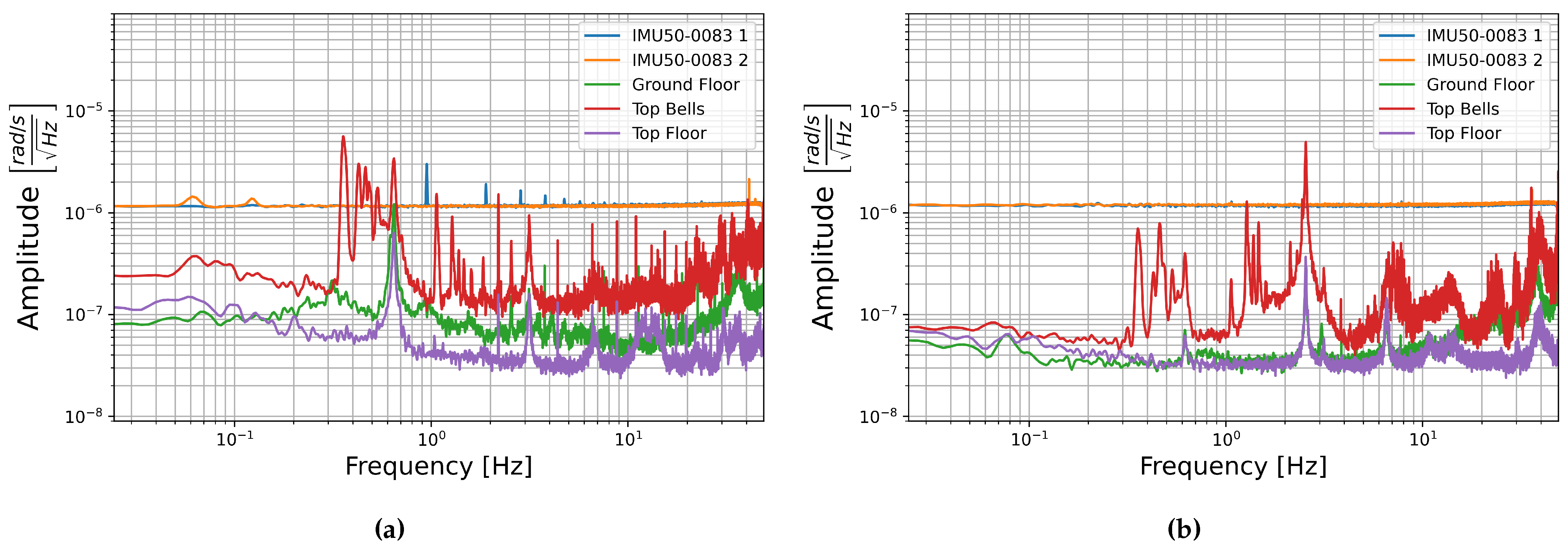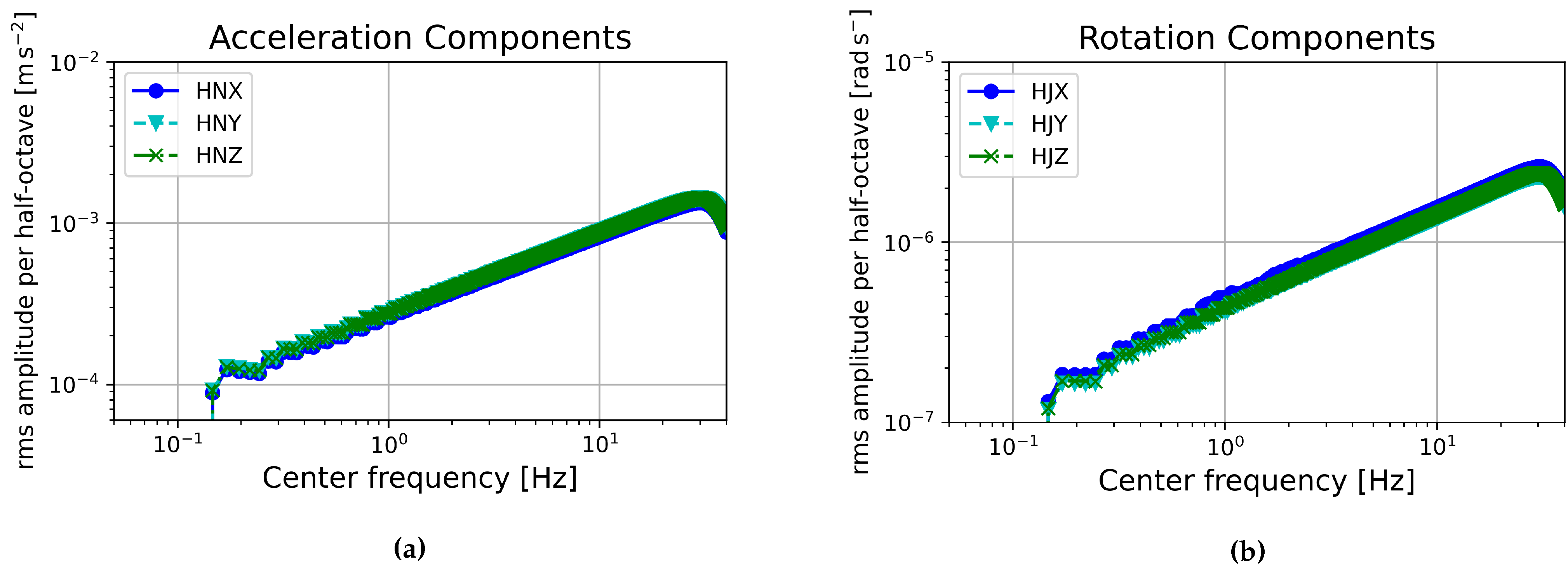1. Introduction
Six-degree-of-freedom (6DoF) sensors measure translational motion along three axes and rotational motion around three axes. The collocation of these measurements is an exciting step forward in seismological instrumentation. Translational motion, such as linear displacement, velocity, or acceleration, has long been measured by seismometers, but the addition of rotational measurements, such as rotation angle or rotation rate, bring significant advantages. The collocation of these measurements can provide improved identification of S-waves allowing for decomposition of the seismic wavefield. Furthermore, these sensors can act as a “point seismic array” to determine the speed, direction, and phase of incoming waves [
1].
There are currently a variety of approaches to measuring translational and rotational data, each developed for specific applications. In seismology, observatory-based high-sensitivity ring lasers collocated with seismometers have been used to record rotational motion from strong teleseismic earthquakes; these observations improve our understanding of the seismic wavefield [
2,
3]. In seismic exploration, array techniques have been developed to compute rotational motion [
1]. A single 6DoF sensor could provide equivalent rotational information, but there is a trade-off, as the array is also able to provide strain and dilatation measurements between stations [
1,
4]. Liquid-based rotation sensors are also used; these show potential for measuring strong motions, but they are sensitive to temperature changes [
5].
In recent years, the benefits of collocated translational and rotational motion measurements have been noted in structural health monitoring (SHM), an emerging field of engineering that has embraced seismic instrumentation and could further benefit from 6DoF sensors. There are certain requirements that a sensor should meet in order to be useful in SHM. Three requirements are suggested by Bernauer et al. in 2012 for rotation sensors in seismology [
5]:
Sensors should not be sensitive to linear motion.
Sensors should be small and stable with respect to changes in ambient conditions.
Sensors should have low enough power consumption to be operable off grid.
A fourth requirement specific to engineering was added by Jaroszewicz et al. in 2016 [
6]:
- 4.
The instrument should be able to measure rotational amplitudes up to the order of in a frequency range from to 100 Hz.
In this paper, twenty 6DoF IMU50 sensors are examined to determine their applicability to SHM. The sensors use three perpendicular silicon-based capacitive microelectromechanical system (MEMS) accelerometers [
7] to measure translational motion, and three Fibre Optic Gyroscopes (FOGs) coiled around the translational axes to measure rotational motion. The FOGs use interferometry to measure rotation rate; interferometry relies on massless photons instead of the motion of a test mass or fluid that would have inertia; thus, the rotational measurements are theoretically independent of translation and should measure pure rotational motion satisfying the first requirement [
8,
9]. The use of MEMS accelerometers and the tight coiling of the FOGs make these sensors small and compact, satisfying the first part of the second requirement. The stability of these sensors under changing ambient conditions must be tested, but in general both FOGs and MEMS accelerometers have been shown to be stable and robust sensors [
5,
7,
10], so the second requirement is satisfied. These sensors have fairly low power consumption, they were originally designed to be used off-grid for navigation [
11], and so the third requirement is met. Finally, the transfer function of a FOG is flat, they generally measure across a wider range of frequencies than that stated in the above requirement, and they have been shown to measure rotational amplitudes on the order of
[
12], so the fourth requirement is also met.
FOGs are a relatively new method of measuring rotation rate, but they have already shown improvement over previous methods of measuring rotational motion. FOGs are already used commercially in navigation [
11], and more recently applications for these sensors have expanded into seismology and engineering [
4,
12]. In marine seismology the collocation of a FOG with an Ocean Bottom Seismometer (OBS) has been shown to increase the signal to noise ratio of the horizontal components of the OBS by removing tilt-contamination [
13].
There are various approaches to SHM; in this paper, we will focus on two main methods: monitoring changes in a building’s eigenfrequencies (frequency domain), and monitoring interstory drift (time domain). These methods detect damage such as cracking or weakening that change the stiffness of the structure leading to a shift in the eigenfrequencies [
14] and larger amplitude interstory drift [
15].
Seismometers and accelerometers have been used to monitor building health for some time [
16]. They can monitor the eigenfrequencies of a building and, when multiple sensors are installed, its eigenmodes [
17] and interstory drift can be estimated [
18]. However, seismometer data, especially in buildings, can be affected by rotations, which could be corrected for with collocated rotation measurements [
19]. It has also been shown that rotational mode shapes are more sensitive to damage and provide more information on damage location, which is a major goal in SHM [
20,
21]. This means that 6DoF sensors could provide a strong advantage in monitoring a buildings eigenfrequencies and eigenmodes, both because the rotation rate information could be integrated and used to correct the accelerometer data for tilt, and because the sensors could simultaneously monitor translational and rotational eigenfrequencies or eigenmodes.
However, to be used for constant monitoring these IMU50 sensors must be sensitive enough to measure ambient building signal, which means the self-noise level of the sensor must be below the amplitude of the ambient building signal. The self-noise of a sensor is the sensor output when there is no input signal. The amplitude of the self-noise can be frequency dependent and relates to the sensitivity of the sensor; signal close to or below the self-noise level can no longer be measured because it is lost in the noise generated by the sensor itself. In this paper, we assess the self-noise levels of 6DoF IMU50 sensors from iXblue and compare the amplitude of the sensor’s self-noise with the amplitude of ambient building noise from two towers: Giotto’s Bell tower in Florence, Italy, and the north tower of the Cologne Cathedral, Germany.
Time domain SHM can be carried out by monitoring interstory drift. Interstory drift can be estimated from seismometer or accelerometer data by integrating to find the difference in displacement between two floors and then using the story height to calculate a tilt angle [
18]. Integration of translational data, especially the double integration required for accelerometer data, can be plagued by small offsets that accumulate over the integration [
15,
22], and as the angle is calculated between sensors the quality of the results is affected by the density of instrumentation [
18]. Single integration of the FOG data would provide the same angle directly at the sensor location, removing the need to average over one or more stories, and as the data need only be integrated once this could be a more reliable measurement [
12]. Once again, for constant monitoring the self-noise levels of the sensors must be below the ambient building signal levels. However, even low-sensitivity sensors that may not be suitable for constant monitoring could be used to monitor interstory drift during higher amplitude shaking events. To determine the potential of the sensors examined in this paper for this type of monitoring, we will again compare the sensor self-noise levels with ambient building signal levels and with higher amplitude shaking from literature.
These sensors are in principle well suited to SHM. Collocated measurements of translational and rotational motion can provide a full description of building motion without the need for an external point of reference, which can become unreliable, especially during earthquake shaking [
5]. The rotation rate data recorded by the FOGs can be integrated to provide the tilt-angle. The tilt-angle provides important information on the building’s interstory drift, and it can be used to correct the MEMS accelerometer data for tilt, which improves the double integration of the data to displacement [
19]. Combining these measurements, the sensor orientation and tilt-corrected displacement can be derived; together, they provide a full description of the building’s motion at the sensor location over time, which is a unique advantage of 6DoF sensors. As well, although there are theoretical methods of wave decomposition to estimate the components of rotational and translational motion, there is no reliable way to estimate the complex interaction effects of these motions [
23]. 6DoF sensors can directly measure translational and rotational motions, which could be used to model the interaction effects in structures for a more complete description of structural motion. Including 6DoF data, especially rotational motions, in building monitoring unlocks an additional set of observables for SHM. Wavefield gradients such as rotational motions are known to be more sensitive to local structure and heterogeneities [
24]. Thus, by including this additional set of observables to SHM (for example, in methods such as coda wave [
25] and ambient noise interferometry), we expect improved performance in characterizing material property changes [
26,
27].
The small size of the sensors makes them easy to install, an advantage in infrastructure monitoring. In addition, both the accelerometers and FOGs are able to measure constant signals, the accelerometers have no AC filter, which makes it possible to use the constant signals of earth’s rotation and gravity as input for calibration, if the position and orientation of the instrument are known. This means that the sensors could potentially be calibrated in situ, which could be used to implement state of health monitoring of the sensors during continuous operation. This further means that the change in gravitational acceleration along the axes of the MEMS accelerometers could be used to calculate the sensor tilt to cross-check the integrated rotation rate data of the FOGs.
The sensors discussed in this paper were provided by the company iXblue to the seismology group at Ludwig-Maximilians University (LMU) Munich to test the potential of such sensors for SHM. The coupling of the more sensitive FOG sensors with relatively cheap MEMS accelerometers is common in navigational instrumentation, but determining whether or not these sensors also fulfill the requirements to be useful in SHM is the focus of this paper. To begin we compare two methods of calibration: the traditional step table method, and calibration using constant earth signals, earth’s rotation rate and gravitational acceleration, as input,
Section 3.1. After calibration the basic performance characteristics of the instruments are tested such as sensor self-noise,
Section 3.2, and temperature dependency,
Section 3.3. The sensor self-noise is examined by computing the Allan deviation and the Power Spectral Density (PSD) of FOG and accelerometer data recorded with no input signal. The sensor self-noise is then compared with ambient building signal,
Section 3.4, and examples of larger amplitude signals such as recorded in buildings during earthquake motion and on bridges from traffic noise,
Section 3.5. These comparisons allow us to draw conclusions about the potential of these sensors for infrastructure monitoring through eigenfrequencies or interstory drift. This is a major task within the project “Gebäudeschwingungen: kombinierte Zustandsanalyse mit innovativem Sensorkonzept” (GIOTTO), financed by the German Ministry of Education and Science.
2. Materials and Methods
The IMU50 sensors examined in this paper have applications in navigation, civil engineering, and seismology [
4,
11,
12]. The use of FOGs gives these sensors an advantage over most other methods of measuring rotation rate as FOGs are theoretically able to measure pure rotation rate. FOGs function by sending light from a beam splitter in two directions around a loop of fibre optic cable coiled around the axis of rotation. The two light beams form a standing interference pattern throughout the cable, when the beams return to the beam splitter they are directed to a photodetector where this pattern is measured [
12]. If the coil is rotated, the optical path length of the two light beams changes, changing the interference pattern that arrives at the photodetector [
9]. This change in the interference pattern is measured as a phase shift, which can be converted to information on the rotation rate. As the measurements rely on interferometry with mass-less photons instead of the motion of a test mass or fluid with inertia, the rotation rate measurements are independent of translation, and thus should measure pure rotation rate [
8,
9].
Temperature can change the refractive index of silica, from which fiber optic cables are made [
28], and changes in the refractive index of the cable could affect the measured interference pattern. The sensitivity of fibre optic cables to temperature has been exploited to measure temperature in other SHM systems [
29]; however, in these sensors the effect could be a disadvantage. In building health monitoring the sensors could see a wide range of temperatures depending on where they are installed in the building and the local weather conditions. Therefore, it is important to test the stability of the sensor measurements with temperature variation. For this purpose, the self-noise of the FOGs and MEMS accelerometers are tested by comparing the PSD of hour-long recordings at temperatures between 14 to 50
C. To assess the stability of the scale or calibration factor of the sensor, one of the FOGs was calibrated with the electric step table over the same temperature range. The MEMS accelerometers require a manual step table for calibration, and therefore could not be calibrated at elevated temperature with the current equipment.
Before the self-noise of these IMU50 sensors can be assessed they must be calibrated. We compare two methods of calibration: the step table method, and calibration using constant earth signals. Absolute calibration is carried out by comparing the sensor output with a known input signal to find the absolute scale factor of the sensor, which is the ratio of the two [
30]. Background noise is problematic during calibration as it changes the recorded signal without changing the expected input signal, thereby changing the measured scale factor, and generally increasing the scatter of the scale factors. To mitigate this problem all sensor data was recorded in the relatively seismically quiet environment of a former instrument test platform in the Ludwig-Maximilians University (LMU) Geophysical Observatory in Fürstenfeldbruck.
After calibration the self-noise of the sensors is assessed by examining the Allan deviation and Power Spectral Density (PSD) of recordings of relatively seismically quiet time spans. The self-noise levels of these IMU50 sensors are compared with ambient building signal levels and higher amplitude shaking induced by earthquakes in buildings and traffic on bridges. This comparison is used to assess the potential of these sensors for the different methods of building health monitoring.
2.1. Method of Calibration of Rotation Components
The rotation components, measured by FOGs, were calibrated in two ways: using a tilt table and by comparison with earth’s rotation rate. All twenty sensors were calibrated using the tilt table method, the scale factors from this calibration method are shown in
Section 3.1.1. For this step a CT-EW1 Step Calibration Table was used [
31]. This table is powered by a small motor that performs uniform and stable up–down movements with a micrometer-precision gauge on each side of the table that can be set to zero to measure the relative vertical displacement from the zeroed position. The maximum displacement produced is 1 ± 0.0005 mm as read from these gauges, however, the variation between readings can be up to 0.02 mm. The table comes with a handheld control box so that it can be operated from a meter or two away, which reduces anthropogenic disturbances near the table.
To create an input rotation a lever was placed between the step table and a stable pedestal. The lever has wheels on one side allowing it to roll freely on the table as it moves up and down. A secondary stable pedestal was placed nearby with a flat metal bridge spanning the distance between the secondary pedestal and the lever. In this way, the table could move up and down, tipping the lever, which tilted the bridge; this setup is shown in
Figure 1.
Steps were made by moving the step table up and down, tilting the sensor by a small angle. Although the electric step table produces uniform steps, the rotation rate is not constant as the table starts and ends in a stationary position. The table does not display the rotation rate or rotational acceleration, but the rotated angle can be calculated from the length of the bridge and the vertical displacement:
where
is the input angle,
a is the factor that depends on how far along the rolling lever arm the extension bridge is placed,
in this case,
h is the height the table moves up or down, 1 mm as read from the gauges on the side of the step table, and
L is the length of the bridge that the sensor is placed on, 405 mm. The resulting rotation angle is
.
This rotation angle was used to calibrate the FOG sensors. However, as the FOGs measure rotation rate in digital counts, the output must first be integrated once to find the rotation angle with units of count seconds. The direct and integrated sensor output are shown in
Figure 2. In
Figure 2a the sensor is first rotated in the negative rotation direction, and then rotated in the positive direction back to the starting point. In the integrated data,
Figure 2b, this can be seen as a rotation in the negative direction to a constant displacement angle, the red section, and then the rotation angle returns to the initial value, the green section.
The step height recorded by the sensor is then the difference between the red and green flat sections shown in
Figure 2b. The locations of the rotation rate peaks, shown in
Figure 2a by the red and green dots, were used to help determine the extent of the flat sections in the integrated output. The average of the red flat area was found by taking the average of all points from the index of the peak with the red dot plus 50 to the index of the peak with the green dot minus 50. In this way, the average of the flat areas, which represent the sensor output in between tilt table motions, could be computed. The sensor measured step height is the difference between the integrated data before and after the sensor was tilted, which is the difference between the red and green flat areas in
Figure 2b. The buffer of 50 points, corresponding to 0.5 s, around the peak rotation rate is to avoid including sensor output from during the motion when the rotation angle is still changing. This was visually chosen to provide a reasonable balance between excluding points during table motion and including a large number of points for the computed average.
The recorded step height in count seconds is then compared with the input angle in radians to find the scale factor of the sensor in count seconds per radian. As the scale factor is time independent, it can be used to convert the raw rotation rate sensor output from counts to radians per second. To reach a robust estimate of the scale factor 16 steps were recorded in two sensor positions for each rotation axis so that the final scale factor for each axis was computed from 32 steps. The average scale factors and the standard deviations of the scale factors are presented in
Section 3.1.1.
The second method of calibration, comparison with the earth’s rotation rate, was tested with one sensor (serial number 0083). Data was recorded in the same basement location of the LMU Observatory from 27 November to 2 December 2019 with a two hour break on 29 November 2019, resulting in two quiet streams of data, hereafter referred to as Stream 1 and Stream 2. This is a low seismic noise environment and so the only input rotation should be earth’s rotation, which is constant, and therefore appears as an offset on the axes. An average scale factor can be found by comparing the offsets of all axes added in quadrature to the total magnitude of earth’s rotation rate. However, the different axes may have unique scale factors, if the exact orientation of the sensor were known this could be calculated separately for each axis using the latitude and orientation. In this case the exact orientation of the sensor was unknown, but the latitude was used to split earth’s rotation rate into vertical and horizontal components and these scale factors were calculated individually.
To find a stable estimate of the scale factor, the stream was split into sections of 6001 points, or 60 s. The scale factor was computed for each section, and then the average scale factor and corresponding standard deviation were computed from all sections. These are compared with the mean scale factor and standard deviation found for the same sensor using the step table method in
Section 3.1.1.
2.2. Method of Calibration of Acceleration Components
The MEMS accelerometers were also calibrated in two ways. First all sensors were calibrated using an OSOP brand manual step table. Due to the shape of the sensors, only the HNX and HNZ components could be calibrated. The manual step table was used instead of the electric step table, which was used to calibrate the FOG sensors, as the manual step table can produce higher amplitude accelerations. This is important as the MEMS accelerometer data has higher amplitude noise levels compared to the input signal than the rotation data had, and the accelerometer data must be integrated twice to find the recorded displacement for comparison with the input displacement of 0.662 mm. The sensor recorded step heights were estimated by manually picking the start and end of the step, shown by the red dots in
Figure 3c on the twice integrated sensor output. The double integration gives the step height units of counts times seconds squared, this is then compared with the step height in meters leading to a scale factor with units of count seconds squared per meter. The direct sensor output is then corrected with this factor by dividing the output in counts by the scale factor, which results in units of meters per second squared.
The manual steps are less uniform, which, coupled with the required double integration and manual step picking, leads to a higher deviation between steps. The accelerometer scale factors are calculated from the average of 18 steps in two positions aligned with each of the HNX and HNZ axes, so each scale factor is the average of 36 steps. The resulting scale factors and the standard deviations of the scale factors are presented in
Section 3.1.2.
As a secondary method, one sensor (serial number 0083) was calibrated using gravity as an input acceleration. The accelerometers can measure constant accelerations, and so earth’s gravity, 9.80782
[
32] in Munich, can be seen as a constant offset on the vertical axis of the two quiet streams described in the previous section. As in the calibration of the FOG sensors, the scale factor was calculated for minute long sections by comparing the mean offset to the acceleration due to gravity. The mean scale factor and standard deviation were then calculated from all sections, the resulting scale factor from each stream is compared with the scale factor for the same sensor calculated using the step table method in
Section 3.1.2.
The standard deviations given in
Section 3.1 represent the over-all uncertainty of the applied calibration procedures. In order to assess the resolution of the sensor measurement we estimate the sensor self-noise that represents the total noise budget of the sensors.
2.3. Method of Self-Noise Analysis
The self-noise of these IMU50 sensors was assessed using the two quiet streams of data recorded in the basement test site with sensor number 0083 between 27 November and 2 December 2019. These are the same streams that were used to calibrate the sensor by comparison with earth signals. The former instrument test platform in the LMU observatory is a low seismic noise environment that should have noise levels below the self-noise levels of the sensor. Before analysis, the data were corrected with the scale factors found using the tilt and step table methods. It should also be noted that the sensor data were recorded directly by a laptop, which also provided the timestamps. To avoid data problems due to the low precision of these timestamps, the sampling rate was kept relatively low at 100 Hz. The data were stored as miniseed files and handled using the open-source Python module ObsPy [
33].
The type of noise present in the sensors was first assessed in the time domain through Allan deviation, the square root of Allan variance. Allan variance is a way of estimating the frequency stability of a signal in the time domain, and characterizing the noise terms in the signal [
34]. The concept was first developed in 1966 by D.W. Allan for characterization of noise in atomic clocks, more recently this method has been adapted for noise characterization of FOGs [
35], and has also been applied to MEMS accelerometers [
36].
The apparent stability of a signal depends on the time scale examined, a signal may contain high frequency noise but have a constant mean over longer time scales, or a signal may be quite smooth, but with low frequency noise causing long-period oscillations. The type or spectra of noise that dominates the signal depends on the time window examined. Allan variance is a metric for signal stability over different time periods. In this paper we use the “Overlapping Allan Deviation” computed using the Python module Allan Tools [
37] by:
where
is the interval between measurements, and
m is an integer such that
is the averaging time for which each overlapping Allan variance
is computed. The overlapping Allan deviation is then the square root of this,
,
N is the length of the data series, and
n is an integer index to sum over the data.
Basically, the Allan variance shows the squared mean difference of the averages of consecutive sections of signal, this makes the Allan variance a function of the averaging time of these sections. Allan deviation is defined as the square root of the Allan variance. A logarithmic plot of Allan deviation as a function of section averaging time
has linear sections, and the slopes have been shown to be characteristic of different noise spectra [
35].
In a similar way the slope of a logarithmic plot of the PSD of a signal indicates the dominant noise type, for example a PSD with a flat mean trend is typical of white noise [
35]. The slopes and the corresponding noise types are summarized in
Table 1, where
represents the slope of the PSD, and
the slope of the Allan deviation, both on logarithmic scale plots. If the Allan deviation shows a slope of −1, there is a modified calculation that can be used to distinguish between White angle/velocity noise, and Flicker or Quantization noise, the slopes of the modified Allan deviation plots are listed below under Modified
[
35].
The Allan deviation was plotted as a function of the averaging times
and linear fitting was used to determine the slope of each linear section. The slopes were then rounded to the nearest half integer to determine the likely noise spectra dominating that time range. The resulting slopes are discussed in
Section 3.2.1.
The noise content was also assessed in the frequency domain by computing the PSD of the self-noise data. The PSD was computed using Welch’s method as described in his 1967 paper [
39]. PSDs were computed using a segment length of
points, or 163.83 s, with an overlap of
, and Hann windowing. The data was low-pass filtered to 49 Hz, just below the Nyquist frequency at 50 Hz.
The PSD can be used to compare the relative amplitudes of signals in the frequency domain and examine a signal’s frequency content. As discussed above, the slope of a logarithmic plot of a PSD of noise data can be used to characterize the dominant noise type in the frequency domain [
38]. The characteristic slopes are shown in
Table 1.
2.4. Method of Testing Temperature Effects
As previously discussed, changes in temperature could affect the interference pattern measured by the FOG sensors, which could affect the scale factor of the sensor. As the sensors could see a wide range of temperatures depending on the installation location it is important to test the extent of these effects both on the FOG and MEMS sensors.
When testing a seismic sensor for temperature effects it is important to find a seismically quiet way of controlling the temperature. This makes the heating step easier, as light bulbs can be used as a seismically quiet way of increasing the temperature. All temperature tests used the same basic setup. Three light bulbs were placed around the sensor so as to be close to the sensor while touching nothing, especially the wires, which could melt. These light bulbs were controlled via a Conrad temperature control system, which allowed the temperature to be set; this control system included a temperature sensor to inform the system if changes were needed. A brick tower was set close to the step table so that the temperature sensor from the control system and the temperature sensor of a METRAHIT TRMS System Outdoor multimeter could be threaded through holes in the tower to hang close together and near the top of the IMU50 sensor.
A Styrofoam cover was then placed over the setup for insulation. In this way, the temperature could be adjusted to range from the background basement temperature, around 15 C, up to about 50 C.
As the FOGs could be calibrated using the electric step table which could be operated with a controller, the effect of temperature on the scale factor of the FOG could be tested with the tilt table. The tilt table setup had to be adjusted slightly to fit under the cover, the bridge was placed directly on the table instead of on the rolling lever arm. The modified setup is shown in
Figure 4a. This modification increased the input rotation angle to
.
After the baseline reading, which was generally in the range of 14–15
C, the temperature controller was set and the sensor was allowed to heat for one hour. An hour was seen as adequate based on similar temperature experiments conducted by Bernauer et al. in 2012. In the 2012 experiment the temperature response of other larger FOG sensors was seen to stabilize within an hour, and as the IMU50 sensors explored here are smaller in size, one hour heating time was seen as sufficient [
5]. The baseline measurements were always taken with the multimeter before the temperature control system was switched on, then during the heating steps, the temperature of the multimeter and controller were recorded.
To test the effect of temperature on the scale factor of FOG component HJY, sixteen steps were recorded at each temperature step. Unfortunately, the high noise levels of the MEMS accelerometers meant that these required a manual step table for calibration, which could not be operated from under the insulating cover, and so the effect of temperature changes on the scale factor of the MEMS accelerometers could not be tested in this paper. If the sensors are deployed in an area with a wide temperature range this should be tested.
To compare the self-noise of the FOGs and MEMS accelerometers at different temperatures sensor number 0347 was set up as in
Figure 4b. Self-noise was recorded at ambient basement temperature and then the controller was set to a temperature and allowed to heat for one hour before recording about an hour of self-noise. For consistency, the recordings were cut to a uniform length of 55 min, and the PSD was computed with a segment length of 40.95 s, and
overlap.
2.5. Method of Comparison with Building Signal
Data was recorded in Giotto’s Bell Tower, Florence, Italy, between 29 November and 30 November 2016 both on the ground floor and on the top floor at around 82 m height. The towers rotational motion was recorded with a prototype blueSeis-3A rotational sensor from the company iXblue, and translational motion was recorded with a Trillium Compact 120 s seismometer from the company Nanometrics. The Trillium seismometer has a bandwidth of −3 dB points at 120 s and 108 Hz and a dynamic range of 159 dB at 1 Hz [
40]. The PSD was computed from hour long sections of recorded data with the instrument response removed. The building signal was recorded with a higher sampling rate of 200 Hz, however for comparison with the IMU50 sensors the PSDs were computed using the same section length and overlap in seconds, that is a segment length of 163.83 s, and an overlap of
.
Data was recorded at 100 m height in the north tower of Cologne Cathedral with an updated prototype of the blueSeis-3A sensor to measure rotations, and a Trillium Compact 120 s seismometer to measure translational motion. Data was recorded over several days, but the data used here was taken from 1 November 2017. As the bells toll for about twenty minutes between 8:40 and 9:00 UTC time, twenty minute sections of data were used here to isolate the bell tolling. The same section length and overlap were used to compute the PSDs.
4. Conclusions
The IMU50 sensors are able to measure constant rotation rates and constant accelerations, this is a unique advantage as the constant signals provided by earth’s rotation and gravity can be used to calibrate the sensors. The calibration scale factors of the FOG sensors were found using the tilt table method and by comparison with earth’s rotation rate. The difference between the FOG scale factors found with the two methods was of the same order of magnitude as the standard deviations and three orders of magnitude smaller than the scale factors themselves, showing that these methods are comparable. The difference between the two methods of calibrating the MEMS accelerometers, the step table method and by comparison with gravity, was only two orders of magnitude smaller than the scale factors, but still within the standard deviation of the step table scale factor. The standard deviations of the MEMS scale factors from comparing the signal with gravity were much smaller, indicating that this could be a better method of calibration, and should be explored further. This method of calibration could also be used to implement state of health monitoring of the sensors to check the scale factors during continuous operation.
The sensors show low sensitivity to temperature variation. The self-noise of the FOGs tends to increase with temperature while the self-noise of the accelerometers tends to decrease with temperature, however, both trends are slight. In the temperature range that these sensors are likely to see for SHM this effect is insignificant, and as the scale factor of the FOG sensors does not appear to be affected by temperature this should not affect the overall performance. The effect of temperature on the scale factor of the accelerometers could not be tested with the available equipment, but this should be tested if the sensors are to be installed outside or in an area where they would be exposed to a wider temperature range.
The comparison of the PSDs of building signal recordings with the self-noise recordings of sensor number 0083 show that ambient building signal generally has lower amplitudes than the sensor’s self-noise. This means that these sensors would not be suitable for ambient noise building health monitoring, however, the sensors could be useful for monitoring building motion during higher amplitude shaking, such as induced by earthquakes. The monitoring of interstory drift by single integration of the FOG data instead of double integration of accelerometer data could increase the quality of interstory drift measurements while requiring fewer sensors making these FOG sensors a powerful new tool in SHM. It has also been shown that traffic can induce high amplitude shaking on some bridges, meaning these sensors could be useful in monitoring the health of certain bridges. These sensors show high potential in the field of infrastructure monitoring, in areas with high signal levels the 6DoF collocated measurements and the ability to theoretically measure pure rotation give these sensors an advantage over previous methods and provide a powerful new tool for public safety.




